One of our “must do” excursions for our visit to Oaxaca was a day driving through the Sierra Madre Mountain Range going from one artisanal Mezcal producer to another with the very knowledgeable Alvin Starkman on his widely acclaimed Mezcal Educational Excursions of Oaxaca. Click the photo to the left to see a video of Alvin providing a technical description of clay pot Mezcal distillation.
Those in our crew of 4 had a passable knowledge of Tequila before our tour but were truly novices when it came to Mezcal. Well rest assured; Alvin took care of that little detail.
After a full day of explanation and demonstration of the process, meeting Master Mezcaleros and in some cases their families and the opportunity to sample 20 or so handmade state-of-the art examples of this fine product; we all felt we had acquired an appreciation and at least a rudimentary working knowledge of Mezcal.
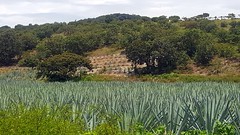 While much of what is considered the best Mezcal is from Oaxaca, the product can be made in 5 contiguous States of Mexico but the distillation must be from 100% of any single or a mix of agave species.
While much of what is considered the best Mezcal is from Oaxaca, the product can be made in 5 contiguous States of Mexico but the distillation must be from 100% of any single or a mix of agave species.
The most commonly used agave now is cultivated (i.e. grown on farms) Agave Angustifolia and that is the main ingredient to making Espadin mezcals. However, many of the most prized examples are made from a wide range of wild agave species. It is the different species of agave used in production that leaves a big imprint on the flavor, but it is far from the only influence.
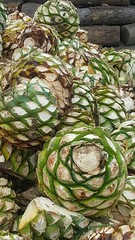 Technically, Tequila actually is a Mezcal when defined as a distilled product made from agave plants. However in order to be called Tequila, the product must produced in the Mexican state of Jalisco or in a few municipalities in other states near Jalisco and contain a minimum of 51% blue agave.
Technically, Tequila actually is a Mezcal when defined as a distilled product made from agave plants. However in order to be called Tequila, the product must produced in the Mexican state of Jalisco or in a few municipalities in other states near Jalisco and contain a minimum of 51% blue agave.
Each mezcalero has his own methods typically learned from his father who learned from his father going back for generations. He decides how long to bake his agave “piñas” named that because they look like pineapples and the texture and the method used to shred them once they are cooked. He decides when the fermentation process is complete and the resulting juices are ready to be distilled. He decides on whether to distill in a copper or a clay pot and what if any flavorings to add in the 2nd or 3rd distillation.
Surely a producer using the same agave and methods 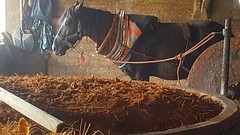 will create a similar product from one batch to another but there are so many variables that the artisanal producer cannot control that each and every batch is unique. That is in contrast to the larger industrialized producers of Tequila and commercialized Mezcal who seek to achieve a standardized consistent product that a consumer can count on to be the same bottle to bottle. In this way, the artisanal mezcalero is more like a fine winemaker and the production borders on being an art form.
will create a similar product from one batch to another but there are so many variables that the artisanal producer cannot control that each and every batch is unique. That is in contrast to the larger industrialized producers of Tequila and commercialized Mezcal who seek to achieve a standardized consistent product that a consumer can count on to be the same bottle to bottle. In this way, the artisanal mezcalero is more like a fine winemaker and the production borders on being an art form.
The tour begins with a very thorough initial indoctrination from Alvin that is reinforced with examples and discussion throughout the day. A sample of that introduction is shown in the video linked in the top photo on this page. But it also includes ample opportunities to taste the product.
Our first stop for the day was at the workshop of Felix Ángeles in Santa 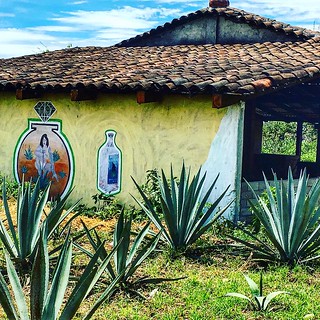 Catarina Minas. Felix distills in clay pots, a method that imparts added nuances to the flavor but at the same time is more labor intensive than copper pot distillation. For his more special varieties, he crushes his baked agave by hand in a small pit and a big pounding stick rather than with a horse or burro pulling a big stone wheel; another more labor intensive choice. Both of these factors add to the uniqueness of his product but also to the price.
Catarina Minas. Felix distills in clay pots, a method that imparts added nuances to the flavor but at the same time is more labor intensive than copper pot distillation. For his more special varieties, he crushes his baked agave by hand in a small pit and a big pounding stick rather than with a horse or burro pulling a big stone wheel; another more labor intensive choice. Both of these factors add to the uniqueness of his product but also to the price.
In fact, the most expensive bottle any of our group bought during the tour was made from wild Tobalá by Felix Ángeles. Tobalá is a variety that provides a lower yield (or liters of Mezcal per ton of raw agave) than most other agaves and using a wild Tobalá translates to more work and cost in sourcing the raw material; both additional factors contributing to the
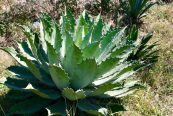 higher price. But I discovered during the day that my own personal favorite flavor was Tobalá and decided to buy a liter bottle for roughly $60 USD.
higher price. But I discovered during the day that my own personal favorite flavor was Tobalá and decided to buy a liter bottle for roughly $60 USD.
I also bought a bottle of a Pechuga from Felix Ángeles that was made with Agave Karwinskii, (the subspecie commonly known as Tobasiche.) 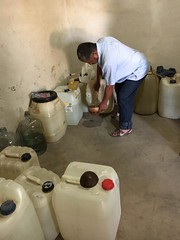 What is Pechuga you might ask? It is a method of adding flavors to the Mezcal during the 3rd distillation. Traditionally, the added flavor is from turkey breast but Felix uses the also acceptable alternative of chicken breast.
What is Pechuga you might ask? It is a method of adding flavors to the Mezcal during the 3rd distillation. Traditionally, the added flavor is from turkey breast but Felix uses the also acceptable alternative of chicken breast.
The meat is hung from the distillation cap and positioned above the liquid being distilled in the pot. It is cooked by the steam developed in the distilling process and that impacts the flavor of the end product.
Not every bottle we purchased that day was so expensive. 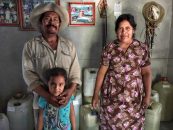 Our group bought a total of 4 bottles from Fortunato Hernández, another mezcalero; all four made from wild agaves including another Tobalá and a Barril. All 4 bottles were priced at roughly $18 USD per liter.
Our group bought a total of 4 bottles from Fortunato Hernández, another mezcalero; all four made from wild agaves including another Tobalá and a Barril. All 4 bottles were priced at roughly $18 USD per liter.
Hernández and his wife Victoria and their son-in-law Pedro make use of a community co-op palenque or distilling facility in San Baltazar Chichicapam. That facility uses a horse for pulling the grinding wheel and distills in copper pots. We got the  chance to taste 1st and 2nd distilled product coming straight from the still and we were shocked at just how smooth (sauve) it was. From the co-op we drove to the home of Hernández and Victoria and sampled a wide range of really good Mezcal.
chance to taste 1st and 2nd distilled product coming straight from the still and we were shocked at just how smooth (sauve) it was. From the co-op we drove to the home of Hernández and Victoria and sampled a wide range of really good Mezcal.
The last mezcalero we visited on our tour was the plant of Juan Hernández, who uses copper pots and is located in Santiago Matatlán, the self-proclaimed “Mezcal Capital of the World” by reputation and by a permanent banner complete with a copper pot and condenser coils across the road entering the town. There are literally hundreds of palenqueros in this small town and Juan Hernández is one of the best. His 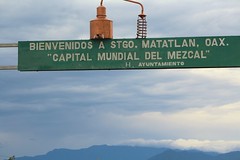 operation had very recently been certified, which translates to legal for export (on a commercial scale) and was the only palenque we visited with that designation.
operation had very recently been certified, which translates to legal for export (on a commercial scale) and was the only palenque we visited with that designation.
Hernández’s daughter, Lidia served us samples of multiples of their offerings including an Espadin añejo aged for 2 years in American oak and an Tobalá añejo aged for 4 years in American oak. As it turns out, my personal favorite Tequilas tend to be añejos but in this case, I did not care for these 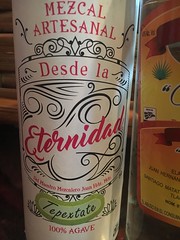 offerings as much as I did for Juan Hernández’s Tepeztate Joven (or unaged) and we bought a total of 6 less-than-liter-sized bottles of that (for the sake of easier packing).
offerings as much as I did for Juan Hernández’s Tepeztate Joven (or unaged) and we bought a total of 6 less-than-liter-sized bottles of that (for the sake of easier packing).
Following our visit to Juan Hernández’s , we stopped in at the roadside Restaurant El Paso in Santiago Matatlán for a lunch of Oxacan cuisine. It was nothing special but a decent lunch at reasonable prices and we got to enjoy some additional Mezcals from Alvin’s traveling stash produced in palenques not included in our tour that day.
A couple days before our tour with Alvin Starkman we had booked a more general tour of many of the excursion highlights for visitors to Oaxaca. We were traveling that day with Tomás Ramirez and touring through the mountains in his comfortable Chevy Suburban. One of the stops he made was near 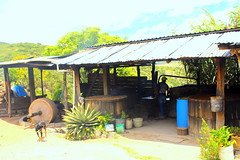 the town of San Lorenzo Albarradas at a small open air shack clinging to the side of a mountain top that houses the palenque known as “Mezcal Zompantle”. The Master Mezcalero here is Santos Martínez. We could see Santos tending his Espadin plants that spread down the mountain side but inside the shack was a mound of dirt covering the agave oven and his son Miguel tending a single steaming copper pot.
the town of San Lorenzo Albarradas at a small open air shack clinging to the side of a mountain top that houses the palenque known as “Mezcal Zompantle”. The Master Mezcalero here is Santos Martínez. We could see Santos tending his Espadin plants that spread down the mountain side but inside the shack was a mound of dirt covering the agave oven and his son Miguel tending a single steaming copper pot.
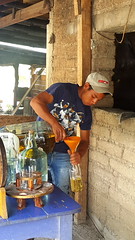 Out in front of the shack was a small table with lots of samples in a mixed bag of bottles and plastic jugs of different shapes and sizes, a small wooden barrel and a 5 gallon glass water jug holding a (minimally aged) Espadin Ropasado . On reflection after our tour with Alvin we all pretty much agreed that what we tasted at El Zompantle was as good as any Mezcal we sampled over our entire stay in Oaxaca. I ended up buying one liter of the Ropasado and another of a very nice Tepeztate at a combined cost of roughly $22 USD or $11 per liter; not bad for a world class spirit. Below is a video showing part of that visit.
Out in front of the shack was a small table with lots of samples in a mixed bag of bottles and plastic jugs of different shapes and sizes, a small wooden barrel and a 5 gallon glass water jug holding a (minimally aged) Espadin Ropasado . On reflection after our tour with Alvin we all pretty much agreed that what we tasted at El Zompantle was as good as any Mezcal we sampled over our entire stay in Oaxaca. I ended up buying one liter of the Ropasado and another of a very nice Tepeztate at a combined cost of roughly $22 USD or $11 per liter; not bad for a world class spirit. Below is a video showing part of that visit.
Alvin’s Mezcal tours can take different routes and he often includes this palenque in his tours but we told him we had already visited Zompantle with his friend Tomás and wanted to see other makers. In fact, when we visited, Tomás was carrying bottles, labels and seals that he had purchased from Alvin to bottle what we bought; a process that is necessary if you plan to take your purchases home with you.
After a stop for lunch we ended our tour day with a visit to a puiquerias for tastes of pulque, a milky, slightly slimy bubbling beverage made by fermenting (not distilling) the  fresh juice of particular agaves. Somebody’s grandmother who didn’t see or hear very well but sure knew what she was doing when it came to fermentation served us samples of day old, 2-day old and 5-day old pulque for pennies per gourd cup; each with a more sharp but pleasing flavor than the last. During the few minutes we were in her small shop, two other groups of people from the village stopped in for a cup as well.
fresh juice of particular agaves. Somebody’s grandmother who didn’t see or hear very well but sure knew what she was doing when it came to fermentation served us samples of day old, 2-day old and 5-day old pulque for pennies per gourd cup; each with a more sharp but pleasing flavor than the last. During the few minutes we were in her small shop, two other groups of people from the village stopped in for a cup as well.
At that point we were about an hour’s drive from Oaxaca City which we spent alternatingly dozing off and marveling at what a great day we had spent.

